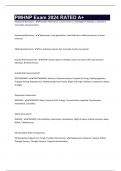PMHNP Exam 2024 RATED A+
Autosomal Dominant - ✔✔Genetic inheritance, is more rare (i.e. Huntington's disease), is present in
more than one generation.
Autosomal Recessive - ✔✔Expressed in one generation, inherited from unaffected parent, is more
common.
CAGE Questionnaire - ✔✔For substance abuse, Cut, Annoyed, Guilty, Eye opener
Suicidal Risk Assessment - ✔✔SLAP: Social support, Lethality, Access to means, Plan and previous
attempts, & family history
Suicidal Risk Assessment #2
ISPATHWARM - ✔✔ISPATHWARM: Ideation, Substance abuse, Purpose for living, Anxiety/agitation,
Trapped feeling, Hopelessness, Withdrawing from friends, Anger with rage, Reckless in behaviors, Mood
changes
Depression Assessment
SIGECAPS - ✔✔SIGECAPS: Sleep, Interest, Guilt, Energy, Concentration, Appetite, Psychomotor
retardation, Suicidality
Mania Assessment
DIGFAST - ✔✔DIGFAST: Distractibility, Indiscretion, Grandiosity, Flight of ideas, Activity increase, Sleep
deficit, Talkativeness
Mental Status Exam Components
(All Borderline Subjects Are Tough Troubled Characters) - ✔✔Appearance, Behavior, Speech, Affect,
Thought Process, Thought Content, Cognitive Examination
,Hamilton Depression Rating (HDRS) for very severe depression - ✔✔more than 23
Hamilton Depression Rating (HDRS) for severe depression - ✔✔19-23
Hamilton Depression Rating (HDRS) for moderate depression - ✔✔14-18
Hamilton Depression Rating (HDRS) for mild depression - ✔✔8-13
Hamilton Depression Rating (HDRS) for no depression - ✔✔0-7
Hamilton Anxiety Rating for moderate to severe anxiety - ✔✔25-30
Hamilton Anxiety Rating for mild to moderate anxiety - ✔✔18-24
Hamilton Anxiety Rating mild anxiety - ✔✔<17
General screening labs - ✔✔CBC, Chem, Thyroid, Hepatic, b12, folate, drug levels
Lithium labs - ✔✔evaluate thyroid function, check creatinine clearance regularly
Depakote labs - ✔✔check hepatic function
Olfactory Nerve
(On) - ✔✔CN I: Sensory: (test by smell- coffee, tea, non astringent smells)
,Optic Nerve
(Old) - ✔✔CN II: Sensory- visual acuity test (confrontation method to assess visual fields)
Oculomotor
(Olympus) - ✔✔CN III: Motor- eye movement (follow penlight through six fields of gaze, test OD, OS
individually)
Trochlear Nerve
(Towering) - ✔✔CN IV: Motor- eye movement (superior oblique-same test as oculomotor)
Trigeminal Nerve
(Tops) - ✔✔CN V: Both- superficial and deep structures of head and face, mastification/corneal reflex
(test by show teeth)
Abducens Nerve
(A) - ✔✔CN VI: Motor- specific eye movements (test same as oculomotor)
Facial Nerve
(Fin) - ✔✔CN VII: Both- taste of anterior 2/3 of tongue, sensation in ear canal, facial movement (use
salt/sugar for taste, evaluate corneal reflex, raise eyebrows, keep eyes closed, and resist attempt to
open, puff cheeks)
Acoustic Nerve
(And) - ✔✔CN VIII: Sensory- Hearing/tickling watch and whisper (tuning fork with Rinne- positive as
normal, when air conduction persists twice as long as bone conduction)
, Glossopharyngeal Nerve
(German) - ✔✔CN IX: Both- Swallow, taste of posterior 1/3 of tongue, pain, touch, and temp of mucosa
and pharynx (check for deviation of uvula to unaffected side)
Vagus Nerve
(Viewed) - ✔✔CN X: Both- Elevation of the uvula (swallow, have patient say aaah and check uvula
elevation, gag reflex, and ability to swallow water)
Accessory Nerve
(A) - ✔✔CN XI: Motor- Innervates trapezius and sternocleidomastoid (shrug shoulders against
resistance, turn head against hand on cheek)
Hypoglossal
(Hop) - ✔✔CN XII: Motor- motor of the tongue (push tongue against the inside of cheek, stick out
tongue and check for fasciculation)
Lithium therapeutic levels (acute mania) - ✔✔0.6-1.2 mEq/L
Lithium therapeutic levels (maintenance) - ✔✔0.8-1.0 mEq/L
Lithium adverse effect level - ✔✔> 2 mEq/L >2.5 mEq/L = seizure, death
Valproic acid therapeutic levels - ✔✔50-120 ug/ml
Sensitivity - ✔✔true positives (the degree to which those who have a disease screen positive)
Specificity - ✔✔true negatives (the degree to which those who not have a disease test negative)




